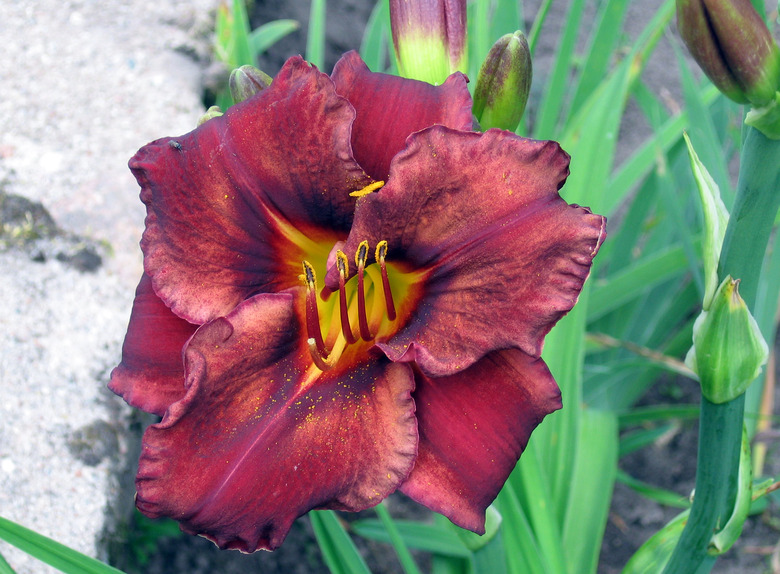How To Grow Daylilies From Seedpods
Growing 1 to 6 feet tall with blooms that last only one day, daylilies (Hemerocallis spp.) flaunt flowers 1 1/2 to 8 inches across where they are perennial, U.S. Department of Agriculture plant hardiness zones varying from 4 through 11. Gardeners in southern U.S. states, such as Florida, can sow daylily seeds by early August and transplant the seedlings into the ground by late September. If the winter is mild, those plants may grow quickly enough to produce flowers the following spring or summer. In the north, however, most daylily seedlings won't bloom until they are at least 2 years old.
Choose Daylily Seeds
Daylilies grown from the seeds of hybrid cultivars may produce flowers that vary in shape and possibly even in color from those of their parent plant. On the other hand, species daylilies such as lemon daylily (Hemerocallis lilioasphodelus, USDA zones 5 through 9) grown from seed can be like their parent plant if they aren't grown near other daylilies with which they may cross.
Harvest Seeds
Round or oval, three-valve, green seedpods appear at the top of daylily stems after the flowers fade. Those pods turn brown and begin to crack open when the seeds inside them are ripe, usually about 50 days after the flowers fade.
The ripe seeds should be shiny black, somewhat wrinkled-looking, round or oval and about 1/4 inch long. Spread them on paper towels, and allow them to dry for one week.
After drying your daylily seeds, place them inside a zip-type plastic bag. Store the dried seeds of deciduous daylilies — those that lose their leaves for winter — inside a refrigerator. Seeds of evergreen daylilies don't require cold temperatures, or stratification.
Sow Seeds
If you live in the South, remove the seeds from the refrigerator after six weeks, and sow them in late summer. If you are in the North, allow the seeds to continue chilling until early spring, about 10 weeks before your location's last average annual spring frost date. In either case, after you remove the seeds from the refrigerator, soak them overnight in a hydrogen peroxide solution to kill fungi — adding 1 tablespoon of hydrogen peroxide to 1 quart of water, along with 1/4 teaspoon of dish detergent to allow the glossy seeds to absorb liquid readily.
The next morning, drain the seeds by pouring them into a strainer held over a sink, and rinse them under water from the tap. Fill a container, which has bottom drainage holes, to within 1 inch of its rim with a moist and sterile seed-sowing mix. After spacing the seeds 1 inch apart on the surface of that mix, cover them with 1/4 inch of damp sand.
Southern gardeners can then place the container in a partially shaded position outdoors, with the container enclosed in a plastic bag. Northern gardeners should cover the container with plastic wrap and position it indoors on a sunny windowsill or under a shop light timed to run for about 15 hours per day, preferably in a room with a temperature of 55 to 65 degrees Fahrenheit. If the mix and sand are kept damp, the seeds may begin to germinate within seven to 10 days, after which their plastic bag or wrap can be removed.
Grow Seedlings
Keep the mix damp, and when the seedlings each have two leaves, begin to feed them once every two weeks with a one-half-strength plant food, using about 1/4 teaspoon of crystals per 1 gallon of water for a chemical 24-8-16 type plant food or 2 tablespoons of emulsion per 1 gallon of water for an organic 3-1-1 type plant food. When the daylilies are 1 month old, you can double the amounts per 1 gallon of water to make full-strength fertilizer.
Once the plants reach 6 inches in height, transplant them into your garden — in early autumn in some southern states, late autumn or early spring in especially hot and humid areas or after the last average annual spring frost date in northern zones. Choose a position in rich and well-drained soil with a pH level of 6.0 to 6.5, and ensure the plants will receive at least six hours of sunlight per day and 1 inch of water per week. Plant them at the same soil depth at which they grew in their pots and 18 to 24 inches apart.
References
- Tallahassee Daylily Society: How to Grow Daylilies
- Southern Michigan Daylily Society: Growing Daylilies from Seed
- The Complete Guide to Saving Seeds; Robert Edward Gough and Cheryl Moore-Gough
- Grace Gardens: How We Grow Our Seeds
- Horticultural Reviews: Daylily — Botany, Propagation, Breeding; Surinder K. Gulia et al.
- Clemson Cooperative Extension: Daylily
- Shields Gardens, The Daylily Place: Planting Seeds
- The New Sunset Western Garden Book; Kathleen Norris Brenzel, Editor
- The Plant Book; Susan Page and Margaret Olds, Editors
